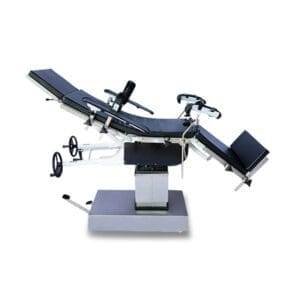Introduction
In the world of healthcare, the design of equipment can profoundly impact the well-being of both patients and medical professionals. Manual Operating Tables (OT tables) are essential tools in surgical settings, providing a stable platform for various medical procedures. However, the importance of ergonomic design cannot be overstated when it comes to these tables. In this comprehensive guide, we will explore the key design features that make manual OT tables ergonomic, ensuring the comfort, safety, and efficiency of healthcare providers and patients alike.
Importance of Ergonomics in Healthcare
 Ergonomics, the science of designing tools and environments to fit the capabilities and limitations of users, plays a crucial role in healthcare. In the context of manual OT tables, ergonomic design directly impacts the safety and comfort of both surgical teams and patients. Here’s why it matters:
Ergonomics, the science of designing tools and environments to fit the capabilities and limitations of users, plays a crucial role in healthcare. In the context of manual OT tables, ergonomic design directly impacts the safety and comfort of both surgical teams and patients. Here’s why it matters:
- Surgeon Comfort: Prolonged surgeries demand ergonomic tables that prevent surgeon fatigue and discomfort.
- Patient Safety: Proper positioning and support reduce the risk of complications during and after surgery.
- Efficiency: Ergonomic tables streamline procedures, enhancing overall surgical efficiency.
Height Adjustment
- Smooth and Precise Mechanism: Manual OT tables should offer easy and precise height adjustments, allowing surgeons to position patients optimally.
- User-Friendly Controls: Intuitive control handles or pedals simplify height adjustments, reducing the risk of errors during surgery.
- Locking Mechanism: Secure locking mechanisms are crucial to maintaining the desired height throughout the procedure.
Tabletop Composition
- Radiolucent Material: The tabletop should be constructed from radiolucent materials, enabling compatibility with imaging equipment such as X-rays and C-arms.
- Padding and Pressure Relief: Adequate padding and pressure-relieving features reduce the risk of pressure ulcers for patients under anesthesia for extended periods.
- Easy-to-Clean Surface: The tabletop should have a hygienic, easy-to-clean surface to maintain a sterile environment.
Trendelenburg and Lateral Tilt
- Gradual Adjustment: The ability to make gradual adjustments to Trendelenburg (head-down) and reverse Trendelenburg (head-up) positions ensures patient comfort and safety.
- Lateral Tilt: Lateral tilt functionality allows for optimal positioning during various surgical procedures.
- Locking Mechanisms: Secure locks prevent unintended movement in tilted positions, ensuring stability during surgery.
Mobility and Locking Mechanisms
- Smooth Mobility: Easy maneuverability and smooth-rolling casters enable seamless movement of the table within the operating room.
- Central Locking System: A central locking system provides a quick and secure way to immobilize the table when needed.
User-Friendly Controls
- Intuitive Controls: Controls for adjusting height, tilt, and other functions should be easy for surgical teams to understand and operate.
- Clear Position Indicators: Clear indicators of table position help surgeons make precise adjustments.
- Emergency Controls: An emergency control mechanism should be readily accessible in case of power failure or equipment malfunction.
Ergonomically designed manual OT tables offer numerous benefits, including:
- Enhanced Surgeon Comfort: Reduced strain and fatigue during long surgeries lead to better outcomes.
- Improved Patient Safety: Proper positioning minimizes the risk of complications, such as nerve damage or pressure ulcers.
- Optimized Efficiency: Streamlined adjustments and controls save time, increasing surgical efficiency.
- Versatility: Ergonomic tables accommodate various surgical specialties and procedures.
FAQ
Q1: Are ergonomic manual OT tables more expensive than standard models?
Ergonomic manual OT tables can have a higher upfront cost, but they offer long-term benefits by improving surgeon comfort and patient safety. The investment is often justified by reduced complications and increased surgical efficiency.
Q2: Do ergonomic manual OT tables require special maintenance?
Like any medical equipment, ergonomic tables should undergo regular maintenance according to the manufacturer’s recommendations to ensure proper functionality and longevity.
Q3: Can ergonomic manual OT tables accommodate bariatric patients?
Many ergonomic manual OT tables are designed to support a wide range of patient weights, including bariatric patients. It’s essential to check the specifications of the specific table to ensure it meets your facility’s needs.
Conclusion
Ergonomic design features in manual OT tables are pivotal to the safety, comfort, and efficiency of surgical procedures. Healthcare facilities that invest in ergonomic manual OT tables not only enhance the well-being of their patients and surgical teams but also optimize their overall operational efficiency. The choice to prioritize ergonomic design in these critical pieces of equipment is a step towards ensuring the best possible outcomes in the operating room.
 Ergonomics, the science of designing tools and environments to fit the capabilities and limitations of users, plays a crucial role in healthcare. In the context of manual OT tables, ergonomic design directly impacts the safety and comfort of both surgical teams and patients. Here’s why it matters:
Ergonomics, the science of designing tools and environments to fit the capabilities and limitations of users, plays a crucial role in healthcare. In the context of manual OT tables, ergonomic design directly impacts the safety and comfort of both surgical teams and patients. Here’s why it matters:-300x300.jpg)
